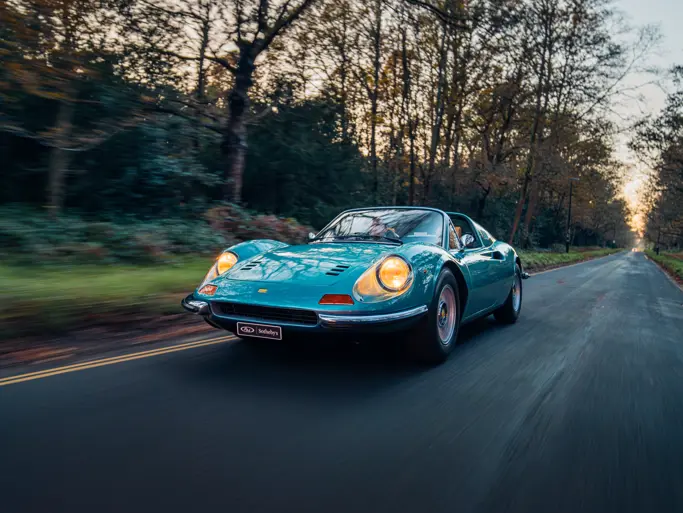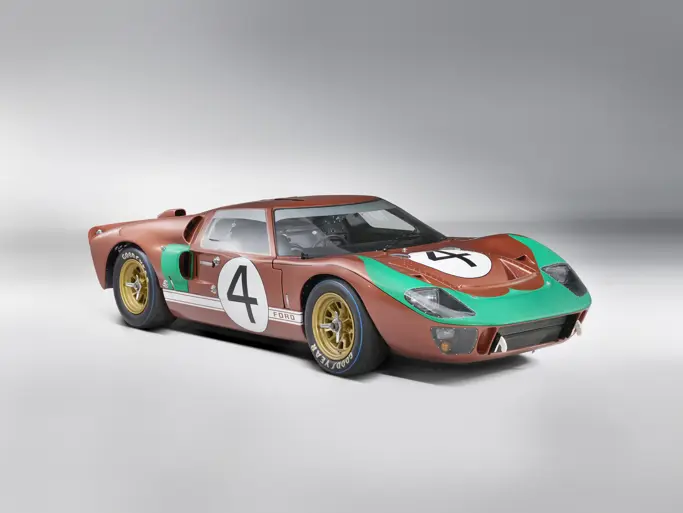The beautiful Shelby GT 350H being offered is a Raven Black with gold stripes Hertz car that was delivered new to Hayward Motors of Hayward, California in March, 1966 for dealer prep. It was then delivered to Hertz in San Francisco where it was part of the fleet until it was subsequently returned to Shelby American on April 13, 1967. On May 31, 1967 the Shelby was delivered via rail to Portland, Oregon and sold to its first private owner, Wes Burmark of Fox Island, Washington. After going through a handful of subsequent owners based in the Pacific Northwest, the Shelby was sold into Florida around 1997. The current owner has retained this car since 2007.
Other than a repaint and "soft restoration," the car is reported to have a largely original interior and undercarriage, and is reported in good condition. The current owner reports that the Shelby has been kept in a climate-controlled storage facility during the course of his possession. Along with being driven by a 289-cid V-8 engine and automatic transmission, the Hertz “rent-a-racer” has Magnum 500 wheels, fiberglass hood, fold-down rear seat, aftermarket AM/FM/cassette player, competition-style Impact seatbelts, plus many other standards that helped set the Shelby apart.
This handsome and uncommon Shelby GT 350H is found in the SAAC Shelby Registry and has been serial number verified by the Shelby American Automobile Club.
A brief background on the origins of this unprecedented model of car:
The Ford Mustang had an amazingly successful introduction in April 1964, selling 22,000 units on the first day alone. The cars popularity was undeniable and the Mustang would become a fixture in the Ford lineup.
The Shelby Mustang came about because Ford division boss Lee Iacocca wanted the Mustang to have more of a high-performance image. He was well aware of the Carroll Shelby managed Ford-powered Cobra sports car team which would capture the 1965 International Sportscar Championship for GT Manufacturers. Shelby was asked to boost the performance of the standard Mustang and was happy to accommodate Iacocca’s request as he applied the desired modifications to the new fastback design.
The street specification Mustang GT 350, introduced for the 1965 model year, sold briskly; however, they were fundamentally thinly-disguised race cars. Some buyers complained about harshness, noise, rattles and unwanted fumes from the exhausts exiting in front of the rear wheels. As a result, the 1966 GT 350 became more user friendly due to a host of mechanical revisions that tempered the edges and made the cars more amenable. Some changes from the 1965 model included the installation of Plexiglass quarter-windows instead of the previous year’s air vents, functional quarter-panel air-scoops that feed cool air to the rear brakes, an optional SelectShift three-speed automatic transmission, the exhaust was extended back further from the cockpit and the Cobra GT 350 logo was added to the gas cap. The interior saw the addition of a fold-down rear-seat, deluxe wood-grain steering wheel and Cobra tachometer. All GT 350s featured competition seat belts. The GT Equipment Group included the high-performance V-8 engine, dual exhaust system, fog lamps, grille bar, special ornamentation, disc-brakes, special handling components package and GT striping.
They found a receptive audience and 1966 sales climbed to a total of 2,380, certainly aided by a large corporate order from the Hertz Rental Car Company. Peyton Cramer, Shelby’s brilliant marketing man and his general manager at the time, was asked to attempt selling fleet sales. Even Shelby must have been surprised when Cramer returned from a sales pitch to Hertz with an order for 1,000 cars. The Hertz Corporation had decided to jump on the performance bandwagon, certainly a major automotive marketing mantra of the mid-1960s. Hertz, as a brave marketing concept, had previously created The Hertz Sports Car Club, whose purpose was to provide a limited number of high-performance rentals to customers “over 25 and qualified to handle such vehicles.” In retrospect any young enthusiast with his, or his dads, credit card was likely “qualified.”
To convey a unique identity, approximately 800 of the Hertz GT 350s were liveried in Raven Black with gold stripes (such as this car) and came with the chrome Magnum 500 wheels. Approximately 200 others were finished in Candyapple Red, Ivy Green, Sapphire Blue and Wimbledon White. Only the black versions and a few white ones had the LeMans stripes on the hood. Some of the earlier GT 350H cars (perhaps 85) had four-speed transmissions, but after checking in more than a few rental returns with burned and slipping clutches, some with bits of racing numbers still stuck to the doors, the majority of later cars came equipped with automatic transmissions.



 | Fort Lauderdale, Florida
| Fort Lauderdale, Florida


